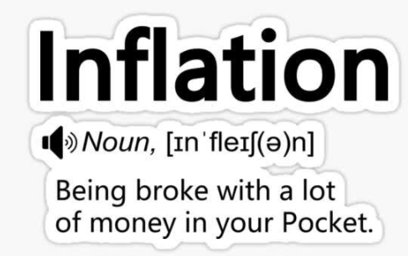MoMo Productions/DigitalVision via Getty Images
Co-produced with Philip Mause
After a long period of hibernation, inflation has recently become the primary concern of many investors, and it is probably helpful to take a long look back to better understand our current situation.
Inflation History
United States inflation history can probably best be divided into three periods of time. Although some arguments can be made, these stages approximately evolved through these years:
- the metallic currency stage, from roughly 1800 to 1933
- the transition, 1933 to 1971
- the fiat money stage, 1971 to the present
Inflation varied enormously over these periods. One way to look at it is that to have the same buying power as one dollar in 1800, it took $1.09 in 1932, $3.21 in 1971, and $23.51 in 2022. In the first 132 years, prices went up only 9%, but then in the next 39 years, prices tripled, and in the most recent 50 years, prices went up nearly 7-fold.
However, this tells only part of the story. Although long-term inflation has been much higher in the fiat money era, it has also been more stable. In the gold era, there were years of massive inflation – for example, 24.75% in 1863 and 20.3% in 1813. This was offset by long periods of actual deflation, including downward spikes of 15% in 1802 and 10.5% in 1921. The range between the highest inflation and the deepest deflation was roughly 40%. In fairness, it should be noted that the high inflation years were generally during wartime (inflation in the Confederate States ran at an annual rate of 200% for most of the Civil War), and these high prices were usually followed by persistent deflation, which pulled prices back to “normal.” The point is that there were significant changes in the value of money year to year that impacted people in very real ways.
In the fiat money era, we have had only one year of actual deflation – 2009 at (0.36%), and all other years have featured inflation. The highest inflation we have had was 13.5% in 1980, which means that the range was only about 14%. This is the argument that the abandonment of the gold standard has produced “price stability”. Inflation occurs at a more consistent level. But, because we have had virtually no real deflation, the net result has been a long-term pattern of increasing prices.
The Retiree
Inflation produces special challenges for the retiree. A member of the workforce can generally anticipate that wages will “keep up” with inflation. This is not always the case, and hardships can be visited on those who are unable to increase their incomes with inflation. But the retiree’s situation is more challenging. By definition, the retiree has no employment income and thus faces the danger that his other sources of income will fail to keep up with inflation over time.
While this problem may not manifest itself in the short run, over a long period, the erosion of spending power can be serious. Thus, longevity and early retirement have produced retirement planning challenges because the number of years in retirement has grown longer and longer. It will be common for many retirees to be in retirement for 30 years or more. Over 30+ years, it is not at all unlikely that prices will double, and there is a danger that even more substantial price increases can occur.
Pensions and Social Security
The good news is that Social Security payments increase with inflation. Arguments can be made that the measurement of inflation is flawed, and it may also be the case that the things that retirees are buying are inflating faster than the overall rate of inflation. But, still, the reality is that Social Security does a pretty good job of protecting the retiree from inflation. This feature of social security must be considered in assessing the age-old debate of whether it is better to start benefits at an early date or wait and thus be entitled to higher benefits. In an inflationary environment, the answer to this question may be, “it depends.”
It may be better to delay taking benefits rather than taking benefits early and using the cash to pay off a 2.5% mortgage. But it is probably better to take the benefits upon reaching retirement age and to use the cash to invest in dividend stocks and other yield-oriented investments rather than waiting.
Pensions vary, and retirees should be aware of the specifics of any pensions that they are entitled to receive. Many have at least some inflation protection.
Housing
Rents obviously tend to go up with inflation – in fact, they are currently a major factor driving inflation up. On the other hand, owner-occupied housing tends to protect the retiree from inflation if he or she has a fixed-rate mortgage or no mortgage at all. But the protection isn’t total. Property taxes, insurance costs, maintenance expenses, and other occupancy costs are likely to increase. The good news is that the property will also tend to appreciate and can – at some point – serve as a “life raft” when it is sold, mortgaged, or reverse mortgaged and produces a nice sum of money.
Retirees with low-interest fixed-rate mortgages should consider the possibility that it makes more sense to continue with the mortgage rather than prepay the mortgage. This is especially true if the prepayment of the mortgage will require the sale of the house and entry into the rental market, thereby exposing the retiree to inflation.
Investments
Many investments can be devastated by inflation. Life insurance and annuities without inflation adjustments can turn out to be a way of converting valuable current dollars into much less valuable future dollars.
Fixed income investments are a dilemma. The battle against inflation generally requires an increase in interest rates which reduces the price of fixed income investments. In addition, the element of the fixed income investment, which involves the ultimate return of principal, becomes less valuable when inflation reduces the value of the dollars that the holder will be paid in the distant future. On the other hand, while inflation expectations are high, fixed income can often trade at discounts. This allows investors to invest at high yields before interest rates are reduced, and inflation gets back under control.
Equities have to be considered by the investor contemplating a long-term retirement. Equities are valued based on earnings, which are the difference between gross receipts and costs. Over the long term, inflation will tend to drive all of these numbers up. When we talk about whether earnings are increasing, whether stock prices are going up, or whether we are in a bear market, we are always talking in terms of Nominal Prices. Stocks may swim around in a river, but the river is almost always moving in the same direction, although it may be moving at different speeds. It is no accident that stock prices are up substantially in nominal terms over the last 50 years – a significant part (although certainly not all) of the increase is simply due to inflation.
However, in the short term, the effort to fight inflation can lead to higher interest rates, which can depress stock prices, as we are seeing now. In this context, dividend-paying stocks are likely to outperform. Dividend-paying energy stocks can somewhat hedge against inflation because there is rarely a bout of extreme inflation without a simultaneous surge in petroleum and natural gas prices. REITs are another group of stocks that may get hammered in the short run but can perform well in the longer term as rent climbs to meet or beat inflation. Some of these securities can be obtained at large discounts by buying CEFs when they are available at large discounts on net asset value.
Rebubble
Conclusion
Some of the traditional rules of thumb and practice for retirees work out reasonably well if the retiree is living in a world with low or no net inflation. But a long view of price performance in the fiat money era makes it clear that that world is unlikely to be the world the retiree actually has to live in and deal with. Retirees have to take long-term inflation into account if they are expecting to retire for a long time.
Our solution at HDO is to ensure that we are focused on growing our income stream, even during retirement. Fortunately, inflationary times will tend to boost earnings and lead to faster-growing dividends in many sectors. BDCs, for example, have been hiking their dividends very aggressively over the past year as they benefit from inflation and rising interest rates.
However, we don’t want to leave the battle against inflation entirely in the hands of the companies we invest in. We also want to ensure that we plan to reinvest a portion of our income. When you were working, you were saving a portion of every paycheck for the future. Keep that habit up, even as your paycheck comes from dividends instead of an employer. You still have a future, you still want to save for it.
Reinvest a portion of your income, and when interest rates are rising, equity prices are falling, and fixed-income investments are on sale, you can reinvest at a higher yield and grow your income faster – helping you keep pace with and beat inflation.


Be the first to comment